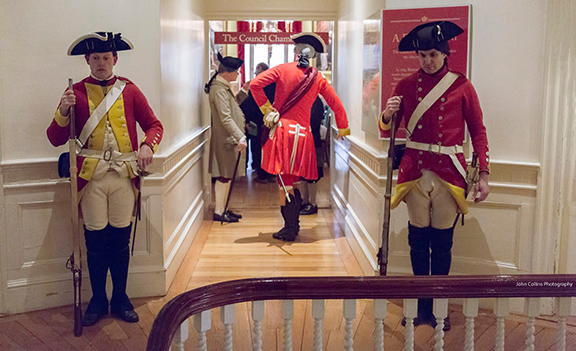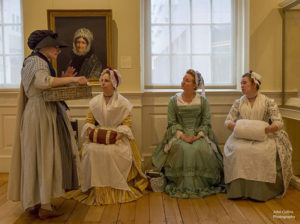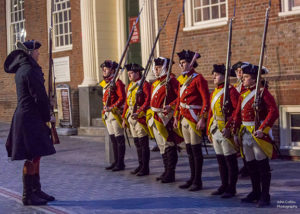 Living history is a unique way to present and experience the past. By interacting with first person historical interpreters and engaging in themed historical events, visitors can gain a better understanding of history that goes beyond an exhibit case or words in a book. When presented properly living history can be both poignant and entertaining. It’s ladies dressed in silk looking as if they’ve stepped from a John Singleton Copley canvas. It’s also troubling, real conflicts ripped straight from the headline of a 1770s letterpress newspaper are brought to life through riots and hanging effigies.
Living history is a unique way to present and experience the past. By interacting with first person historical interpreters and engaging in themed historical events, visitors can gain a better understanding of history that goes beyond an exhibit case or words in a book. When presented properly living history can be both poignant and entertaining. It’s ladies dressed in silk looking as if they’ve stepped from a John Singleton Copley canvas. It’s also troubling, real conflicts ripped straight from the headline of a 1770s letterpress newspaper are brought to life through riots and hanging effigies.
Just as life today is complicated, so is history. And just as life today is fun, so is history. Living history is a way to experience complex issues from the past in settings with deep historical significance with the advantage of engaging real people who are trained to tell complicated stories in entertaining ways. Facilitating these complicated stories through civilian-based history events has become an area of expertise for the Newport Historical Society.
This year marks the 250th anniversary of one of the most significant events that influenced the start of the American Revolution, the Boston Massacre. It’s a story that generations of school children learned while studying American history: on March 5, 1770, British soldiers, who were harassed by a mob, shot and killed five men.
To help mark this anniversary year, the Newport Historical Society has partnered with Revolutionary Spaces, the new organization formed through the merging of The Bostonian Society and the Old State House, to present The Boston Massacre Reenactment and Commemoration.
 Over 100 costumed living historians traveling from 12 states and Washington, DC will convene in downtown Boston to illustrate the tensions that were present in March 1770. This one-day reenactment features two parts, Life Before the Boston Massacre, which runs from 1pm-5pm, and the 7pm presentation which recreates the “Incident on King Street” and concludes with a ceremony commemorating the 250th anniversary and remembering the lives that were lost.
Over 100 costumed living historians traveling from 12 states and Washington, DC will convene in downtown Boston to illustrate the tensions that were present in March 1770. This one-day reenactment features two parts, Life Before the Boston Massacre, which runs from 1pm-5pm, and the 7pm presentation which recreates the “Incident on King Street” and concludes with a ceremony commemorating the 250th anniversary and remembering the lives that were lost.
The schedule and interpretative scenarios are outlined below. Admission costs $12 per person which includes admission to both of Revolutionary Spaces’ historic sites, partaking in the indoor programming at both sites and participation in the walks along Washington Street. The outdoor programming at the Irish Famine Memorial, the vignettes outside of the Old State House and the evening reenactment-commemoration ceremony are free, donations welcome.
Life Before the Boston Massacre 1pm-5pm
The Old State House, 206 Washington Street, Boston, MA
Experience a 1770 Council Meeting in the Council Chamber, learn about the women of 1770 Boston and see the new exhibit Reflecting Attucks in Representatives Hall.
Outside the Old State House:
• 1pm: Changing of the guard
• 1:15pm: A football match
• 4:30pm: Isabella Montgomery meets with Susannah Cathcart
• 7pm: Boston Massacre Reenactment & Commemoration
Old South Meeting House, 310 Washington Street, Boston, MA
Visit interpretative stations around the meeting house which include the Royal Exchange Tavern, the Almshouse, an elegant tea and the office of rope walk owner John Gray. See trades demonstrations including leatherworking, sewing a sailor’s hammock and recreating a British regimental coat. At 4pm, learn about the uniforms worn by the 29th Regiment of Foot.
Edes & Gill Print Shop, Faneuil Hall, 4 Market Street, Boston, MA
Meet historical interpreters portraying Henry Pelham and Paul Revere on March 30, 1770 as they debate about the Boston Massacre engraving.
 Washington and School Streets at The Irish Famine Memorial:
Washington and School Streets at The Irish Famine Memorial:
• 1:30pm: Sons of Liberty songs
• 2:15pm: Tensions run high between rope workers and British soldiers
• 3:15pm: Sons of Liberty songs
Along Washington Street:
Join a mini walking tour led by a resident of 1770 Boston. This short walk connects Old South Meeting House (OSMH) and the Old State House (OSH) at designated times.
• 2pm: OSH to OSMH
• 2:30pm: OSMH to OSH
• 3pm: OSH to OSMH
• 3:30pm: OSMH to OSH
• 4pm: OSH to OSMH
• 4:30pm: OSMH to OSH
Text by Elizabeth Sulock, Newport Historical Society Director of Programs
*Photographs are courtesy of John Collins